|
|
 |
|
 |
|
Velid Đekić INDUSTRIAL AND TECHNICAL HERITAGE Kvarner’s industrial heartbeat 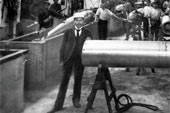 If
you could go back in time and walk around certain parts of the Kvarner
area some one hundred years ago, for example the western outskirts of
Rijeka, you would encounter a surprising scene. The coastal strip of
land was dotted with dozens of factory chimneys, poking up into the sky
and doing what chimneys have always done: belching out smoke. These
chimneys indicated the energetic industrial life going on beneath them,
for this was the western industrial zone of the town. And they were
tall, visible symbols of the fact that Kvarner was one of the most
important industrial areas in Croatia. To be more accurate, Rijeka, the
largest town on Kvarner, was Croatia’s industrial heart at the end of
the 19th and beginning of the 20th century, the town where 50 percent of
Croatia’s industry was then concentrated. If
you could go back in time and walk around certain parts of the Kvarner
area some one hundred years ago, for example the western outskirts of
Rijeka, you would encounter a surprising scene. The coastal strip of
land was dotted with dozens of factory chimneys, poking up into the sky
and doing what chimneys have always done: belching out smoke. These
chimneys indicated the energetic industrial life going on beneath them,
for this was the western industrial zone of the town. And they were
tall, visible symbols of the fact that Kvarner was one of the most
important industrial areas in Croatia. To be more accurate, Rijeka, the
largest town on Kvarner, was Croatia’s industrial heart at the end of
the 19th and beginning of the 20th century, the town where 50 percent of
Croatia’s industry was then concentrated.If you walked the same path again today, bearing in mind what you have just read, you would be surprised yet again, maybe even more than before. What used to be the outskirts of the town are now its centre. And the skyline of chimneys has also changed - very few of them are still there; so few in fact that you could count them on the fingers of one hand. And the smoke? You can spot it only on rare occasions. What were the reasons for this change of scenery? In the 1990s, the years of transition, and at the beginning of the new millennium, most of Croatia's industrial plants disappeared forever. Even the mighty industrial plants on Kvarner could not avoid that destiny. And the factories in Rijeka were the first to go. Still, the winds of this new economy could not completely erase these plants from the memory of Kvarner’s inhabitants. Moreover, in many cases the material proofs of their existence can still be found across the region, reaching from archive documents (for example about the construction of the powerful Szent István warship) to direct contact with a witness of the scenery that you would have encountered in the 19th century. One of them is the gasworks in the part of the town called Mlaka, one of the last preserved constructions from the time of the region’s industrial heyday. Why does most of the oldest industrial and technical heritage on Kvarner date back to the 19th century? The answer is simple: that was when the modern industrial world was really born. But we should not forget that such industrial development would not have been possible without some historical forerunners, including the oldest types of manufactures. There are many examples that show that these formed the basis for industrial development on Kvarner. One important name is Ivan Krstitelj Rabljanin. Born on the island of Rab in the 1470s or 80s, he became the most successful Croatian bronze caster. He cast his largest bell in Dubrovnik in 1506. It weighs more than two thousand kilograms and still rings out from the city tower. He probably also created the bronze figures that hammer out the hours on the bell. He also cast cannons for defending the Dubrovnik Republic, such as the cannons in the Minčeta fortress. Casting hot metal was not restricted to the coastal area, but was also done in the hinterland. In 1651 the Croatian noble family of Zrinski opened smelting plants and forging works in Čabar that were used to cast iron for more than 130 years, up to 1785. How huge these works were we can assume from the fact that in the 1720s two hundred people worked there. Other places where ore and iron were smelted were Brod na Kupi (from 1770), Crni Lug (from 1779), and Homer near Brod (from 1792). Some of these ironworks continued operating until the beginning of the 19th century; with the ore for them being extracted in Delnice, Crni Lug, Mrzla Vodica, Lič and Lokve. 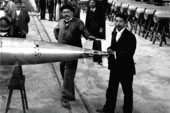 High-temperature
furnaces had one of their most important advocates right here on
Kvarner. Vince Wartha, one of the most famous Hungarian chemists, was
born in Rijeka in 1844. After his father, an army officer, was
transferred to Szeged, Wartha left his native town to study chemistry in
Budapest, Heidelberg and Zürich. He gained his reputation from an
important discovery for the development of the ceramics industry, that
is, by innovating the method of coating ceramics with paint. Kvarner is
also the birthplace of a technical solution that significantly improved
the traditional way of fishing worldwide. For centuries, fishermen would
sail off for a night’s fishing and lure fish by lighting fires. But that
all changed in 1898 in Rijeka when Giovanni Delaitti devised an
acetylene gas lamp whose intensity was equal to the light of 400
candles. High-temperature
furnaces had one of their most important advocates right here on
Kvarner. Vince Wartha, one of the most famous Hungarian chemists, was
born in Rijeka in 1844. After his father, an army officer, was
transferred to Szeged, Wartha left his native town to study chemistry in
Budapest, Heidelberg and Zürich. He gained his reputation from an
important discovery for the development of the ceramics industry, that
is, by innovating the method of coating ceramics with paint. Kvarner is
also the birthplace of a technical solution that significantly improved
the traditional way of fishing worldwide. For centuries, fishermen would
sail off for a night’s fishing and lure fish by lighting fires. But that
all changed in 1898 in Rijeka when Giovanni Delaitti devised an
acetylene gas lamp whose intensity was equal to the light of 400
candles.Do we need to say that these and similar technical achievements made Kvarner an area that was predestined for strong industrial development? Many of these industrial achievements had to do with the sea. This coastal area had always been steeped in maritime history, which resulted in many shipyards across the region. Almost every coastal town had one, and they were kept very busy: in a period of some ten years, from 1850 to 1861, 301 sailing ships were launched in the shipyards in Rijeka alone, with a capacity of 110 thousand tons. These were ships of extraordinary quality. One of them became the flagship of the Argentinean navy under the name Restaurador Rosas. Another sailing ship, the Splendido, sailed around the globe between 1851 and 1859 under Captain Ivan Visin. Also connected to the sea was the Rijeka sailcloth factory, the only one of its kind in Croatia. Rijeka was also the location of the three most important Croatian rope factories. Beside ropes, ships need metal, lost of metal. And not only ships. With that in mind, of Croatia’s six foundries in the mid-19th century, five were opened in Rijeka. The largest among these employed four hundred workers in 1854. The Rijeka chemicals factory was the only one of its kind in Croatia in 1852. At that time, the town had a soap factory, a candles factory and four leather works, as well as 98 flourmills, including Croatia’s first steam-powered mill, which was commissioned in 1853. Many factories sprang up in the second half of the 19th century: a furniture factory, parquet flooring factory and steam sawmill, trunks and barrels factory. Furthermore, there were fabrics, chemical fertilisers, marine coatings, bricks and cement products, cognac, ice, chocolate and sweets, and two oil factories. Of Rijeka’s twenty thousand inhabitants, five thousand worked in industry. At the end of the 19th century, Rijeka and its surroundings became one of Europe’s most strongly concentrated industrial zones. How strongly the town was influenced by its industrial plants we know from the fact that even today its eastern part is called after one of these works. The lead melting plant that operated here in the period between 1911 and 1929 gave its name to the part of the town called Plumbum. With Rijeka being such a strong centre of industry, industrial plants were started elsewhere on Kvarner. For example, after Rijeka got its sardine-tinning factory by the 1860s, fish canneries were opened in the town of Cres on the island of the same name, and in Ika near Opatija. Some of Kvarner’s industrial plants ceased to operate in the 19th century, but some of them continued on well into the 20th century. The huge industrial plants attracted a large number of workers from the continental parts of the former Yugoslavia in the second half of the 20th century, which increased the number of Rijeka’s inhabitants. Today this is no longer the case. Active industrial plants, especially the former large factories, declined in number significantly, but nevertheless – or maybe exactly because of that – the value of Kvarner’s industrial heritage is increasingly being recognised. Recently many international meetings of professionals and scientists have taken place in Kvarner, chosen as their venue for its technical heritage. There are ever more people walking around Kvarner whose points of interest are – the tall, old factory chimneys. 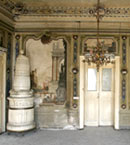 The
Sugar Refinery, the so-called Zuccheriera, was the first and oldest
industrial plant in Rijeka. It was established in 1750 as a plant for
processing sugar cane and raw sugar from overseas. Since the refinery
was located right by the sea, raw material would be unloaded from the
ships directly to the factory’s entrance. The factory area of 17
thousand square metres was criss-crossed by water channels that were
used for the production. The refinery employed several hundred workers
in Rijeka and the hinterland, and had representative offices throughout
Europe (Vienna, Graz, Lisbon, Levant) and worldwide (Philadelphia,
Santiago de Chile, Crimea). In the heyday of the company in 1786, a new
administrative building was added, one of the largest factory buildings
on the Adriatic. The refinery was closed in 1828, but the magnificent
late baroque building still serves as a reminder of its past. The
Sugar Refinery, the so-called Zuccheriera, was the first and oldest
industrial plant in Rijeka. It was established in 1750 as a plant for
processing sugar cane and raw sugar from overseas. Since the refinery
was located right by the sea, raw material would be unloaded from the
ships directly to the factory’s entrance. The factory area of 17
thousand square metres was criss-crossed by water channels that were
used for the production. The refinery employed several hundred workers
in Rijeka and the hinterland, and had representative offices throughout
Europe (Vienna, Graz, Lisbon, Levant) and worldwide (Philadelphia,
Santiago de Chile, Crimea). In the heyday of the company in 1786, a new
administrative building was added, one of the largest factory buildings
on the Adriatic. The refinery was closed in 1828, but the magnificent
late baroque building still serves as a reminder of its past.The Tobacco Factory appeared in Rijeka in 1851 when it took over the buildings of the former Sugar Refinery, which in the meantime had served as barracks due to their size. The Tobacco Factory added new production buildings to the existing factory complex, thus becoming the largest tobacco processing plant in the Monarchy. One of the new buildings was the Virginia cigars production line from 1867, popularly known as the T-Building because of its ground plan. Close to it were two old production buildings that were connected in the middle, resulting in a H-shaped ground plan. During the first years of production, the Factory employed some one thousand workers, and by the mid-1860s this number had doubled. It is interesting to mention that more than half the employees were women. The factory was closed by the end of World War II. In the period between 1945 and 1998, the same buildings housed the Rikard Benčić Engine Factory. Beside the administrative palace inherited from the Sugar Refinery, the preserved T-Building and H-Building today still stand as reminders of the Tobacco factory. The Rijeka Gasworks was commissioned in a most spectacular way: it enabled the illumination of the town on the summer night of 1st August 1852 with 226 gas lamps with fan-shaped flames. This date was important not only for Rijeka, as this was the first plant of its kind in Croatia and the former Yugoslavia. It also made possible the introduction of gas illuminations to the Rijeka Theatre in 1856. The gasworks were first located in the city, and then, from 1874, at a new location outside the town, in the western industrial zone where its production capacity was significantly increased from 400-500 thousand cubic metres gas in the 1850s to two million cubic metres gas at the eve of World War I. In 1878, Rijeka had 318 gas lamps, and by the end of the 19th century, 511. The last of these was turned off in 1939. Gas production has continued until today, with a gradual change to natural gas since 1995. Today this is the responsibility of the Energo municipal services company. A “two-storey” telescopic gasometer (gas storage tank) from 1910 was used in the gasworks for a very long time - up until 1992. The Mill in Žakalj was the largest industrial flour mill in Rijeka. It was constructed in 1841 in the canyon of the River Rječina as one of the 27 mills built in the area, most of them in the mid-19th century. It was a part of the company Stabilimento commerciale di farine. After a fire in 1862 it was renovated and enlarged to six floors 90 metres in length and 25 metres in height. In its heyday it employed 300 workers who annually produced as many as 250 thousand truckloads of flour that was transported in barrels to Istria, Dalmatia, Trieste, England, Germany, France, Egypt and Brazil. The Žakalj Mill was a part of the Stabilimento company until 1881, but in the following year it became part of the new Mill joint-stock company. The mill was closed in 1894, and in 1918 it was sold to the Hungarian Beer Company from Budapest, which wanted to build a beer factory in Žakalj. But after the borders were moved following the war, the access road and the mill were suddenly divided between two countries, so the plans to produce beer could not be realised. Žakalj began to dilapidate. The high ivy-covered walls of the production building along the River Rječina are a reminder of its past. Today the mill in Žakalj is a romantic ruin. The sawmill in Crikvenička Draga, in the hinterland of Crikvenica, was first mentioned as early as 1428 – indeed it is one of the oldest sawmills anywhere in the world with documented proof of its existence. In charge of that water sawmill on the small river of Dubračina were Paulist monks who operated it, together with their mills, by permission of Duke Nikola Frankopan. The timber came from his forests and was sent to Venice. Due to technological development, such sawmills would with time be pushed into the background. The first steam sawmill in Croatia was opened in 1850 in Bijela Vodica near Crni Lug in Gorski kotar by the timber merchant from Grobnik, Nikola Durbešić. The sawmill had six log frames, each with one or two saws powered by a 25-horsepower steam engine from 1830. Here mainly beech wood was processed and made into pieces of board for lemon and orange packaging needed by merchants in Italy. The sawmill in Bijela Vodica did not remain the only one of its kind for long. Already by the next year Josip Velasti had built a steam sawmill in nearby Prezid, and after that another steam sawmill was constructed in Ravna Gora. The sawmill in Bijela Vodica probably disappeared in a fire in 1885. The tradition of shipbuilding on Kvarner has a long tradition and goes back to the times of the Liburnians, an Illyrian tribe. Their ships, the “Liburnian galleys”, were the elite sailing vessels of the Roman imperial fleet because of their quality. In more recent times, shipbuilding flourished again on the island of Lošinj in 1824. The town of Mali Lošinj had six shipyards in the 19th century. Because of that, Mali Lošinj became a European centre of shipbuilding and shipping – for some time it held second place in the Austro-Hungarian Empire for the number of long-distance sailing ships that were made there. By the second half of the 19th century it had almost 150 sailing ships, more than the whole of neighbouring Istria. Sailing reached its peak in the period between 1855 and 1870, when 1,400 captains and sailors from Lošinj were working away at sea. Some of the most renowned shipbuilders and shippers from Lošinj were the families of Karatanich, Tarabochia, Martinolich (who later founded the shipyards in Monfalcone), and Cosulich (present owners of a shipping company in Trieste). In Punat on the island of Krk, a shipyard that produces wooden ships from 1922 is still operating and is today the largest shipyard of its kind on the Croatian Adriatic. The Ana Marija (Ann Mary) steamship was the first vessel of the Austrian navy to be driven by steam engine. This wooden ship was launched in 1835 from the shipyard in Kraljevica. This event marked the flourishing of shipbuilding in Kraljevica in that period, and the credit for that goes primarily to the Pritchard family that owned the shipyard from 1835. The Ana Marija was also the first steam-powered ship to enter the port of Rijeka, which happened in 1836. The Kvarner shipyards played an important role in building ships for the Austrian fleet, which had particular importance at some key moments. The Rijeka Technical Factory (Stabilimento tecnico fiumano) constructed steam engines that were used to power Austria’s warships in the battle of Vis in 1866. Some of the credit for defeating the Italian fleet goes to the excellent quality of the engines from Rijeka. The Hrvat (Croat) steamship, the first Croatian steamship, was built in the Rijeka Technical Factory (Stabilimento tecnico fiumano) to plans by the Rijeka engineer Otto Schlick and launched on 13th July 1872 as the first ship of its kind built on the Croatian coast for a domestic customer. It was ordered by the Shipping society from Senj that intended to establish a line of passenger and cargo ships between Rijeka and Senj. The ship was made of iron, was 34.65 m long and 4.80 m wide, and powered by a 130-horsepower steam engine. It had a capacity of 82 gross register tons and a crew of nine. Regular passage between the two harbours was established on the 7th September of the same year. Initially it sailed five times a week in summer and three times a week in winter, with stops in Novi Vinodolski, Selce, Crikvenica, Voz, Kraljevica and Bakar. The ship sailed under the flag of the Ungaro-Croata shipping company. It was sold in 1903 in Mali Lošinj where it was renowned, and resold to Izola under the name of Besenghi. It disappeared from the list of ships in 1916. 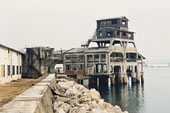 The
Torpedo Factory in Rijeka came into being thanks to Giovanni Luppis
from Rijeka who came up with the idea for a naval defence weapon that
would “guard the coast”. Luppis had that idea in the early 1860s, but
had not enough technical knowledge and means to put it into practice.
Robert Whitehead, manager of the firm Stabilimento tecnico fiumano, got
interested in Luppis’s idea and made and tested a prototype on 20th
December 1866. For the test launchings, he installed his invention, the
launching tube, on the gunboat Gemse in 1868. This was done in the
Rijeka shipyard of Schiavon Brothers, making Gemse the first torpedo
ship in the world. In 1875, Stabilimento became the Torpedo Factory R.
Whitehead & Co., the first torpedo factory in the world, with an annual
production of 800 torpedoes for customers from Great Britain, France,
Italy, Germany, Sweden, Japan, Argentina, Russia etc. The factory opened
production works abroad, and later licensed production worldwide.
Production of this weapon continued in Rijeka until 1966. At the site of
the former Torpedo factory there is still a launching ramp from the
1930s. The
Torpedo Factory in Rijeka came into being thanks to Giovanni Luppis
from Rijeka who came up with the idea for a naval defence weapon that
would “guard the coast”. Luppis had that idea in the early 1860s, but
had not enough technical knowledge and means to put it into practice.
Robert Whitehead, manager of the firm Stabilimento tecnico fiumano, got
interested in Luppis’s idea and made and tested a prototype on 20th
December 1866. For the test launchings, he installed his invention, the
launching tube, on the gunboat Gemse in 1868. This was done in the
Rijeka shipyard of Schiavon Brothers, making Gemse the first torpedo
ship in the world. In 1875, Stabilimento became the Torpedo Factory R.
Whitehead & Co., the first torpedo factory in the world, with an annual
production of 800 torpedoes for customers from Great Britain, France,
Italy, Germany, Sweden, Japan, Argentina, Russia etc. The factory opened
production works abroad, and later licensed production worldwide.
Production of this weapon continued in Rijeka until 1966. At the site of
the former Torpedo factory there is still a launching ramp from the
1930s.The Rice-Husking Plant and Starch Factory in Rijeka was at the moment of its commissioning the largest rice-husking plant in the Austro-Hungarian Empire and one of the largest works of its kind worldwide. It was commissioned in 1882 and annually processed up to 50 thousand tons of rice that was delivered from Rangoon. The factory initially employed 400 workers – this number would increase with the increased processing capacity of the factory. For example, in 1910 the factory processed 70 thousand tons of rice. The rice-husking plant was closed after World War I, and in 1936 its land and buildings were bought by the neighbouring Oil Refinery. The largest building of the Rice-husking plant, the 117 metres-long and 28 metres-wide five-storey production building from 1882, was adapted by the new owner for a new purpose. In order to become the Refinery's administrative palace, this edifice was entirely re-designed by the architect Enea Perugini according to the customs of Italian state art of the time, in the novecento style. The Palace has been used for the same purpose ever since, attracting great attention due to its monumental size. The Rijeka Oil Refinery was founded in 1882 and put into operation in 1883 as the largest oil-processing plant in Europe. It was built to the plans of the Rijeka architect Mato Glavan. In contrast to other refineries of that time, which were organised like manufacturing plants, the Rijeka Refinery had an initial annual capacity of 60 thousand tons, a workforce of 300 and a professional chemist as director. Therefore it was the first industrial oil-processing plant in Europe. Rijeka is the birthplace of the oil industries of two EU member states: Hungary (whose authority Rijeka came under when the Refinery was founded) and Italy (after World War I, the Refinery was the “core of the Italian oil programme” and the first industrial plant of the state firm Agip in 1926). The Refinery’s plant in the part of town called Mlaka is today one of the oldest active refineries worldwide, with a preserved chimney from 1883 and some oil product tanks from 1883 and 1884. Peter Salcher (1848 – 1928), professor at the Rijeka Naval Academy, was a close associate of Ernst Mach and succeeded in what the famous physicist could not achieve - to make a picture of the invisible. Mach wanted to provide experimental evidence of his hypothesis about the existence of a “shock wave” around objects moving at speeds greater than the speed of sound. Therefore, he asked Salcher to try gaining such evidence in his laboratory in Rijeka. No sooner said than done. In 1886, Salcher and his associate Sandoro Riegler took a series of ultra-fast photographs of the acoustic phenomena that arise around a flying gun bullet, thus proving the existence of the “shock wave”, today also known as the “sound barrier”. His work was a scientific sensation. Could the unit for the speed of sound, instead of Mach, have been Salcher? We’ll leave that question unanswered and just remember that Salcher during his experiment actually took the first ever photographs of – a flying bullet. The Lighthouse at the beginning of Baračeva Street in Rijeka originally stood in the main harbour basin, at the end of the Maria Theresa breakwater, where it was erected to the plans by Lajos Luigi Burgsatller in 1884, at the heyday of the building and traffic expansion of the port of Rijeka. This expansion reached its peak in 1914 when the port of Rijeka had the eighth largest turnover in Europe. The iron lighthouse is 31 metres high and has a reflector 1.2 m in diameter. Its light used to flash white and red and could be seen from a distance of 10-15 nautical miles. Shortly after, the part of the breakwater with the lighthouse began sinking, so the lighthouse had to be dismantled and removed. It was erected again in 1893, at its present location. In 1933 it was dismantled and erected again, this time being higher and reinforced with concrete buttresses to the plans by Andrea Bayer. Today it is interesting for two reasons: as a direct reminder of the history of Rijeka harbour, and as a symbol of the “entrance” to the former western industrial zone of the town. An electric carbon filament bulb, the oldest known in Croatia, has been located in Rijeka’s Teatro Fenice cinema. Who was the first to turn it on, when and why, we do not know. Since the Teatro Fenice was built in 1914, it is possible that the bulb also dates from that time. However, since it is similar in shape to the bulbs used on the 4th October 1885 to illuminate the newly opened Municipal Theatre in Rijeka (800 such bulbs were used on that occasion), it is also possible that it dates back to as early as 1885. If that can be proven, this bulb from Rijeka will become the world’s oldest still-functioning electric light bulb. It is a so-called Edison’s light bulb, a model created by Thomas Alva Edison in the second half of the 19th century. It is powered by a voltage of 110 V, and its resistance when cold is 1350 Ohm. It is interesting that the first electrical lighting in Rijeka appeared on the 30th of August 1881 when a Hungarian engineer Károly Zipernowsky (who later invented the transformer as we know it today) introduced a lighting system at the Zichy gate. The first electric power plant was constructed in Rijeka in 1890 for the needs of the harbour and the railway.  The
tanker Etelka entered the so-called “Petroleum harbour” of Rijeka on
the 12th of December 1892, bringing 3,500 tons of oil from the harbour
of Batumi on the Black Sea. It was built for the Rijeka Oil Refinery and
is remembered as the first and only tanker of the Austro-Hungarian
Empire. Moreover, it was one of the first ships of its kind in the
world, especially if we have in mind open-sea steel tankers. The Etelka
was built in the same year that the Shell company acquired its first
tanker, nine years before Texaco. Being the product of its time, the
Etelka was powered by a steam engine and wind energy. It could reach a
speed of 10 knots, had a capacity of 3,620 tons, was equipped with 12
tanks for liquids, and had a crew of 24. It subsequently changed owners
and names, becoming known as Vesta (from 1909, as part of the
Austro-Hungarian navy), Marte (from 1922, as part of the Italian Royal
navy), Procione (from 1926, owned by the Agip company), and then again
as Marte (from 1936). It was sunk in 1944 in the waters off Livorno. The
tanker Etelka entered the so-called “Petroleum harbour” of Rijeka on
the 12th of December 1892, bringing 3,500 tons of oil from the harbour
of Batumi on the Black Sea. It was built for the Rijeka Oil Refinery and
is remembered as the first and only tanker of the Austro-Hungarian
Empire. Moreover, it was one of the first ships of its kind in the
world, especially if we have in mind open-sea steel tankers. The Etelka
was built in the same year that the Shell company acquired its first
tanker, nine years before Texaco. Being the product of its time, the
Etelka was powered by a steam engine and wind energy. It could reach a
speed of 10 knots, had a capacity of 3,620 tons, was equipped with 12
tanks for liquids, and had a crew of 24. It subsequently changed owners
and names, becoming known as Vesta (from 1909, as part of the
Austro-Hungarian navy), Marte (from 1922, as part of the Italian Royal
navy), Procione (from 1926, owned by the Agip company), and then again
as Marte (from 1936). It was sunk in 1944 in the waters off Livorno. 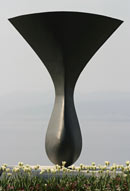 The
Szent István, one of the largest warships in Europe, was launched on
the 17th of January 1914 from Rijeka’s Ganz-Danubius shipyard, a
shipyard that was commissioned in 1905 thus continuing the local
tradition of shipbuilding and becoming one of the most important
production plants in Rijeka’s industry. To the order of the
Austro-Hungarian Navy (K. und K. Kriegsmarine), the keel of the ship was
laid in 1912, and the ship was finished in January 1916. It was 152
metres long and 28 metres wide, with lateral armour 280 mm thick. It
could reach a speed of 21 knots and had a crew of 38 officers and 1,060
NCOs and sailors. The Szent István began her voyage at an unlucky
moment. On the 10th of June 1918 it was hit by a torpedo in an ambush
near the small island of Premuda. The pride of the Austro-Hungarian navy
and Rijeka shipbuilding then sank forever to the bottom of the sea. The
shipyard continued producing destroyers, submarines, torpedo boats, mine
layers, and cruisers. Today it operates under the name of 3. maj. The
Szent István, one of the largest warships in Europe, was launched on
the 17th of January 1914 from Rijeka’s Ganz-Danubius shipyard, a
shipyard that was commissioned in 1905 thus continuing the local
tradition of shipbuilding and becoming one of the most important
production plants in Rijeka’s industry. To the order of the
Austro-Hungarian Navy (K. und K. Kriegsmarine), the keel of the ship was
laid in 1912, and the ship was finished in January 1916. It was 152
metres long and 28 metres wide, with lateral armour 280 mm thick. It
could reach a speed of 21 knots and had a crew of 38 officers and 1,060
NCOs and sailors. The Szent István began her voyage at an unlucky
moment. On the 10th of June 1918 it was hit by a torpedo in an ambush
near the small island of Premuda. The pride of the Austro-Hungarian navy
and Rijeka shipbuilding then sank forever to the bottom of the sea. The
shipyard continued producing destroyers, submarines, torpedo boats, mine
layers, and cruisers. Today it operates under the name of 3. maj. 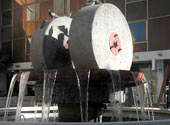 The
Hartera Paper Factory in Rijeka was founded in 1821 thanks to the
entrepreneurial spirit of Andrija Ljudevit Adamić. In 1827, Walter C.
Smith and Charles Meynier bought his manufacturing plant located along
the River Rječina and expanded and modernised it, first by introducing
the most up-to-date paper-producing machine in the Monarchy, and then in
1833 with the first steam engine in Croatia and the Balkans. The factory
had a workforce of one thousand in the 1870s. The paper from Rijeka was
a top-quality product that was awarded many international quality prizes
at the end of the century (Vienna, Barcelona, Budapest, Melbourne,
Paris). In 1940 it was exported to 40 countries worldwide. The
production of cigarette paper started in 1890 and lasted for more than a
century. It was Europe’s second largest factory in 1991 in terms of the
amount of cigarette paper produced. After operating for more than 180
years, the Hartera went bankrupt in the 1990s. However, some of the
oldest buildings and machines have been preserved, including the
impressive 83-metres-high chimney of the factory’s electric power plant
from 1930. The
Hartera Paper Factory in Rijeka was founded in 1821 thanks to the
entrepreneurial spirit of Andrija Ljudevit Adamić. In 1827, Walter C.
Smith and Charles Meynier bought his manufacturing plant located along
the River Rječina and expanded and modernised it, first by introducing
the most up-to-date paper-producing machine in the Monarchy, and then in
1833 with the first steam engine in Croatia and the Balkans. The factory
had a workforce of one thousand in the 1870s. The paper from Rijeka was
a top-quality product that was awarded many international quality prizes
at the end of the century (Vienna, Barcelona, Budapest, Melbourne,
Paris). In 1940 it was exported to 40 countries worldwide. The
production of cigarette paper started in 1890 and lasted for more than a
century. It was Europe’s second largest factory in 1991 in terms of the
amount of cigarette paper produced. After operating for more than 180
years, the Hartera went bankrupt in the 1990s. However, some of the
oldest buildings and machines have been preserved, including the
impressive 83-metres-high chimney of the factory’s electric power plant
from 1930.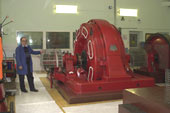 The
Zeleni vir hydroelectric power station
in Skrad, popularly known as the Munjara, is one of the oldest
electric power plants still operating in Croatia. The idea for its
construction dates back to 1898, but its realisation had to wait until
the beginning of World War I when F. Hatzinger made a general design for
the plant. The Munjara was built in 1921 and commissioned in 1922. The
event took place in a strait canyon, some 70 metres from a high
waterfall and the small pond of Zeleni vir. It marked the beginning of
electrification for the Gorski kotar region, including the construction
of the first transformer stations in the Gorski kotar region, in Skrad
and Kupjak (1921). The founder and co-owner of the power plant Josip
Lončarić used the electricity produced for, among other things, his
sawmill in Skrad, which thus became the first electric-powered sawmill
in the area. This sawmill operated from 1925 until 1975. In 1922, the
hydroelectric power plant produced 91,190 kWh, in 1930 it produced
938,600 kWh, and in 1975 as much as 8,065 million kWh. In 1944 it
provided electricity for the whole coastal region up to Crikvenica and
Novi Vinodolski. The Munjara power plant is today a part of the
Nikola
Tesla hydroelectric power station in Tribalj. The
Zeleni vir hydroelectric power station
in Skrad, popularly known as the Munjara, is one of the oldest
electric power plants still operating in Croatia. The idea for its
construction dates back to 1898, but its realisation had to wait until
the beginning of World War I when F. Hatzinger made a general design for
the plant. The Munjara was built in 1921 and commissioned in 1922. The
event took place in a strait canyon, some 70 metres from a high
waterfall and the small pond of Zeleni vir. It marked the beginning of
electrification for the Gorski kotar region, including the construction
of the first transformer stations in the Gorski kotar region, in Skrad
and Kupjak (1921). The founder and co-owner of the power plant Josip
Lončarić used the electricity produced for, among other things, his
sawmill in Skrad, which thus became the first electric-powered sawmill
in the area. This sawmill operated from 1925 until 1975. In 1922, the
hydroelectric power plant produced 91,190 kWh, in 1930 it produced
938,600 kWh, and in 1975 as much as 8,065 million kWh. In 1944 it
provided electricity for the whole coastal region up to Crikvenica and
Novi Vinodolski. The Munjara power plant is today a part of the
Nikola
Tesla hydroelectric power station in Tribalj.The Savannah nuclear ship, the first nuclear-powered merchant ship, was built to the plans of Erazmo Tićac. Born in Žurkovo in 1904, Erazmo went to schools in Žurkovo, Kostrena and Bakar, and made a career as a shipbuilding engineer in the USA. After the president Dwight Eisenhower announced his decision to build an experimental nuclear-powered merchant ship on the 15th of April 1955, the planning was entrusted to the firm The Sharp Brothers Inc., and Tićac became the leading planner. The ship was launched on the 21st of July 1959; her maiden voyage started on the 31st of January 1962, and regular service started in 1963. It had two reactors, could reach a speed of 21 knots and with one fuel of tank it could sail for almost three and a half years. It docked in Rijeka harbour several times, first on the 19th of November 1966. On a plaque above the entrance to the ship’s lounge was written in golden letters: »Ben Tićac, naval architect«. Erazmo got the name Ben when he received American citizenship. After fulfilling all expectations, the Savannah continued to sail until 1971 when she was moored as a floating-museum in her home port of Savannah. Tićac also designed a special landing ship dock (LSD), a military transport ship Victory, and many other ships. Until his death in 1968 he was a member of several renowned American associations of shipbuilding engineers. The Veli Jože floating crane was named after the giant from a story by Vladimir Nazor. It was built in 1949 in Rotterdam for the Brodospas boat salvaging and tugging company from Rijeka and came to the Adriatic Sea in 1950. The Veli Jože is the largest and the most powerful crane on the Adriatic, and for many years in the whole Mediterranean area as well. The colossus weighs 330 tons; it could lift 350 tons of cargo (three Diesel locomotives) at a height of 35 metres. Its arms are 40 metres tall, with an extension arm of 17 metres more. The pontoon on which it stands is a small island 40 metres long and 18 metres wide. During half a century, the Veli Jože lifted more than two thousand ships from the sea bed. In the mid-1950s it was used to lift cut up parts of the largest passenger ship built in Italy, the Rex, which was lying stranded near Izola after being bombed in 1944. The crane was also used to connect the arches of the Šibenik, Pag and Krk bridges. It became internationally famous for taking part in cleaning the Suez Canal in 1956 and 1957. Besides that, the Veli Jože operated in the Persian Gulf; it helped construct the first nuclear power plant in Spain on the banks of the River Tajo; it assembled oil and gas platforms, unloaded Westinghouse generators… Today it is moored in Split, the town where the Brodospas company has its headquarters today. 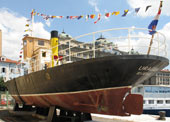 The
steamship Uragan was launched, probably in the 1870s, in Hamburg as
a ship for collecting waste from ships and piers. The shape of the hull,
with a cruiser’s stern and a bow like a sharp axe, riveted metal plates,
a wooden deck and a telegraph with a “chain” transmission, led to the
conclusion that the ship was built at a time when steam-powered ships
were wining the battle against sailing ships. The Uragan is 21 metres
long and 5 metres wide, weighs 40 tons and has a capacity of 250 tons.
It only came to the Adriatic after World War II, as part of war
reparations. During the reconstruction of Rijeka’s harbour, it was used
to transport stone blocks and other material for construction of the
waterfront. It then changed owners, was used for underwater
explorations, and “acted” in movies. Under the name Henriette it can be
seen in the movie Around the World in 80 Days. What was its last job? It
appeared in the TV series The Winds of War with Robert Mitchum. After it
was moored for years in Sušak harbour, it sank to the bottom on the 20th
of October 1999. It was then raised and left lying sideways on the
Zagreb pier, counting its last days. But that was not the end. The
refitting of the ship was completed in December 2004, and since 2005 it
has been moored in Rijeka harbour. The Uragan is a monument to the naval
tradition of Rijeka and all harbours worldwide. The
steamship Uragan was launched, probably in the 1870s, in Hamburg as
a ship for collecting waste from ships and piers. The shape of the hull,
with a cruiser’s stern and a bow like a sharp axe, riveted metal plates,
a wooden deck and a telegraph with a “chain” transmission, led to the
conclusion that the ship was built at a time when steam-powered ships
were wining the battle against sailing ships. The Uragan is 21 metres
long and 5 metres wide, weighs 40 tons and has a capacity of 250 tons.
It only came to the Adriatic after World War II, as part of war
reparations. During the reconstruction of Rijeka’s harbour, it was used
to transport stone blocks and other material for construction of the
waterfront. It then changed owners, was used for underwater
explorations, and “acted” in movies. Under the name Henriette it can be
seen in the movie Around the World in 80 Days. What was its last job? It
appeared in the TV series The Winds of War with Robert Mitchum. After it
was moored for years in Sušak harbour, it sank to the bottom on the 20th
of October 1999. It was then raised and left lying sideways on the
Zagreb pier, counting its last days. But that was not the end. The
refitting of the ship was completed in December 2004, and since 2005 it
has been moored in Rijeka harbour. The Uragan is a monument to the naval
tradition of Rijeka and all harbours worldwide. |
|
|
|
|||||
 THE KVARNER COUNTY TOURISM OFFICE 51410 Opatija, Nikole Tesle 2, tel: +385/51/272-988, fax: +385/51/272-909 http://www.kvarner.hr, e-mail:kvarner@kvarner.hr |
|||||